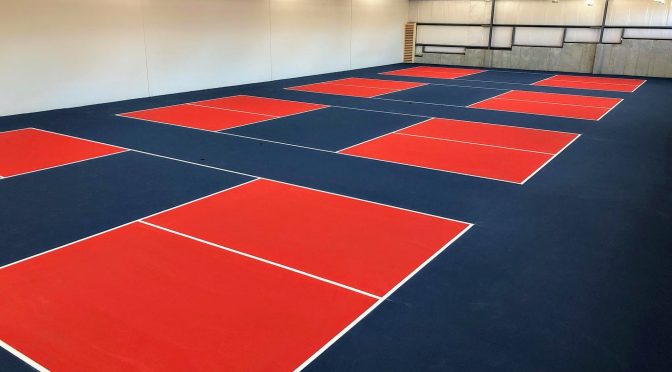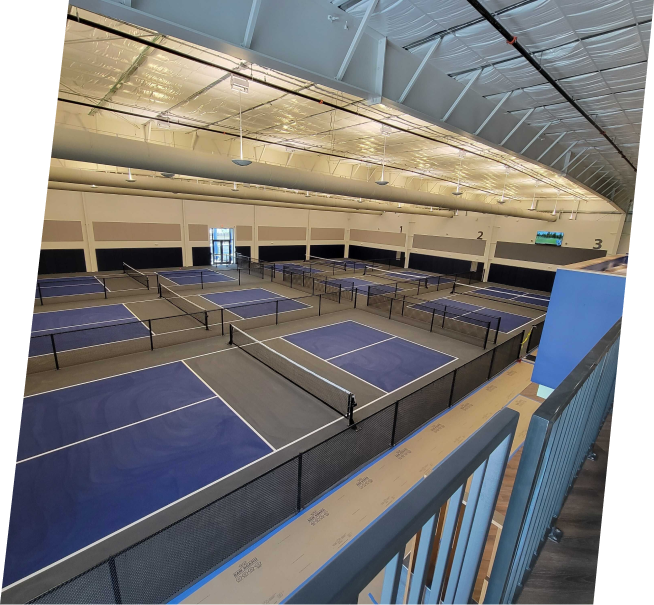A Comprehensive Overview to Designing the Perfect Pickleball Court for All Ability Levels
Designing a pickleball court that provides to players of differing ability degrees necessitates a multifaceted technique, encompassing essential elements such as court measurements, surface area products, and ease of access features. What specific considerations must be prioritized to ensure a successful implementation?

Comprehending Court Dimensions
Understanding the measurements of a pickleball court is critical for both designers and gamers, as these requirements make sure a reasonable and constant playing experience. A typical pickleball court determines 20 feet large by 44 feet long for both singles and increases play. The court is split into two equivalent halves by a web that stands 36 inches high at the sidelines and 34 inches at the facility.
Key attributes of the court include the non-volley area, frequently referred to as the "kitchen," which expands 7 feet from the internet on both sides. This location is vital for controling gamer motion and volleying, ensuring critical play. Furthermore, the solution areas on each side of the court are essential, determining 10 feet broad and 15 feet deep, made to fit proper serving strategies.
Bordering the court, an area of at the very least 10 feet should be designated as the safety and security area, allowing players sufficient space to relocate and avoid injuries during play. Complying with these measurements not just promotes reasonable competitors yet additionally advertises security and pleasure for all participants, making it essential for any kind of pickleball court style.
Selecting the Right Surface
The choice of playing surface area for a pickleball court dramatically influences the game's characteristics and gamer experience. Selecting the suitable product is crucial for making certain player performance, safety and security, and convenience. Usual surfaces consist of asphalt, concrete, and specialized sports floor covering.
Asphalt is a popular choice because of its affordability and resilience. It supplies a regular having fun surface but can be difficult on joints over expanded play. Concrete, while similar in longevity, supplies marginal adaptability, potentially resulting in increased effect on gamers' bodies.
For a much more cushioned experience, many centers choose customized sporting activities floor covering, such as modular ceramic tiles or artificial surface areas. These products commonly include shock-absorbing buildings, lowering the danger of injuries and improving player convenience. Moreover, such surfaces can improve round bounce consistency, which is important for reasonable play.
When picking a surface, consider variables such as climate, maintenance needs, and the intensity of play. An appropriate surface area not only enhances gameplay yet likewise adds to the longevity of the court itself. Eventually, understanding the subtleties of different products will aid in developing an ideal pickleball environment customized to various ability degrees.
Optimal Court Format
An ideal court layout is crucial for making the most of both player performance and viewer enjoyment in pickleball. The measurements of a conventional pickleball court are 20 feet wide by 44 feet long for doubles play, keeping a clear limit that enhances gameplay. The web, positioned at 36 inches high at the sidelines and 34 inches in the facility, is critical for preserving the characteristics of the video game.
Integrating designated locations around the court for web gamers to move openly is important. A minimum of 10 feet of clearance on all sides of the court is advised to stop collisions and supply space for spectators. In addition, positioning plays a significant function; the court should ideally be aligned north-south to lessen the influence of sun glare on gamers throughout height hours.
Noticeable and clear court markings aid in gameplay, with contrasting colors for borders and non-volley areas that define important areas for players. On the whole, a properly designed court design fosters an engaging setting for both gamers and spectators.

Availability Considerations
When making a pickleball court, guaranteeing access for all players, consisting of those with impairments, is extremely important. A thoughtfully made court can promote inclusivity and urge involvement from people of varying capabilities.

Accessibility courses to the court have to also be thoroughly prepared. Make sure that paths causing the court are vast sufficient for mobility device customers and are outfitted with ramps where necessary. Signage should be large and clear enough to be easily read.
Furthermore, seating areas ought to be developed to permit easy access to and from the court. This includes providing designated spaces for viewers that may have movement challenges.
Lastly, ensure that toilet centers close-by satisfy availability requirements. By considering these elements, you can develop a pickleball court that is inviting and usable for everyone, therefore promoting a lively and diverse community of gamers.
Maintenance and Upkeep
Correct upkeep and upkeep of a pickleball court are important for making certain optimum playing problems and extending the lifespan of the center. Routine inspections must be conducted to recognize and attend to any problems or use, such as splits in the surface area or loose netting. These concerns, if left ignored, can negatively influence gameplay and security.
Surface area upkeep is crucial; courts need to be cleaned up regularly to remove particles, leaves, or dirt that can influence traction. For tough courts, regular stress washing is advised to maintain surface stability and looks. If your Web Site court is made from softer materials, such as asphalt, securing or resurfacing might be essential to protect against weather-related wear.
In addition, net height and stress should be inspected routinely, as inappropriate setups can modify gameplay. Maintaining surrounding locations, consisting of fencing and illumination, is just as important for guaranteeing a secure and enjoyable setting.
Conclusion
In conclusion, the design of an ideal pickleball court necessitates a thorough strategy that incorporates correct dimensions, suitable surface area products, and thoughtful design. By adhering to these guidelines, the excellent pickleball court can be produced, promoting enjoyment and sports growth for you could check here gamers of varying ability degrees.
Designing a pickleball court that provides to gamers of varying ability degrees requires a multifaceted approach, incorporating necessary aspects such as court dimensions, surface area products, and ease of access attributes.Recognizing the dimensions of a pickleball court is crucial for both developers and players, as these specifications make sure a constant and reasonable having fun experience.The choice of playing surface area for a pickleball court substantially influences the video game's dynamics and gamer experience.An ideal court format is necessary for maximizing both player efficiency and spectator enjoyment in pickleball. By sticking to these guidelines, the best pickleball court can be created, advertising enjoyment and sports development for players of differing skill levels.